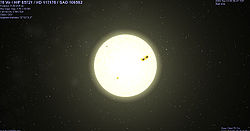70 Virginis
| Observation data Epoch J2000.0 Equinox J2000.0 |
|
|---|---|
| Constellation | Virgo |
| Right ascension | 13h 28m 25.81s |
| Declination | +13° 46′ 43.6″ |
| Apparent magnitude (V) | +5.00 |
| Characteristics | |
| Spectral type | G2.5Va |
| U−B color index | 0.26 |
| B−V color index | 0.71 |
| V−R color index | 0.39 |
| R−I color index | 0.36 |
| Variable type | none |
| Astrometry | |
| Radial velocity (Rv) | 5 km/s |
| Proper motion (μ) |
RA: −236.02 ± 0.24 mas/yr Dec.: −575.73 ± 0.19 mas/yr |
| Parallax (π) | 55.60 ± 0.17mas |
| Distance | 58.7 ± 0.2 ly (17.99 ± 0.05 pc) |
| Absolute magnitude (MV) | +3.70 ± 0.01 |
| Details | |
| Mass | 1.12 M☉ |
| Radius | 1.9 ± 0.1 R☉ |
| Luminosity | 2.92 ± 0.03 L☉ |
| Surface gravity (log g) | 3.58 cgs |
| Temperature | 5,406 ± 64 K |
| Metallicity [Fe/H] | −0.06 dex |
| Age | 7.9 Gyr |
| Other designations | |
| Database references | |
| SIMBAD | data |
| Exoplanet Archive | data |
| ARICNS | data |
| Extrasolar Planets Encyclopaedia |
data |
70 Virginis (abbreviated 70 Vir) is the Flamsteed designation of a yellow dwarf star approximately 59 light-years away in the constellation Virgo. It is rather unusually bright for its spectral type and may be just starting to evolve into the subgiant phase.
In 1996, 70 Virginis was discovered to have an extrasolar planet in orbit around it. There is also a dust disc with a maximum temperature of 153 K located at a minimum distance of 3.4 AU from the star.
Coordinates: ![]() 13h 28m 25.8s, +13° 46′ 43.5″
13h 28m 25.8s, +13° 46′ 43.5″
...
Wikipedia

